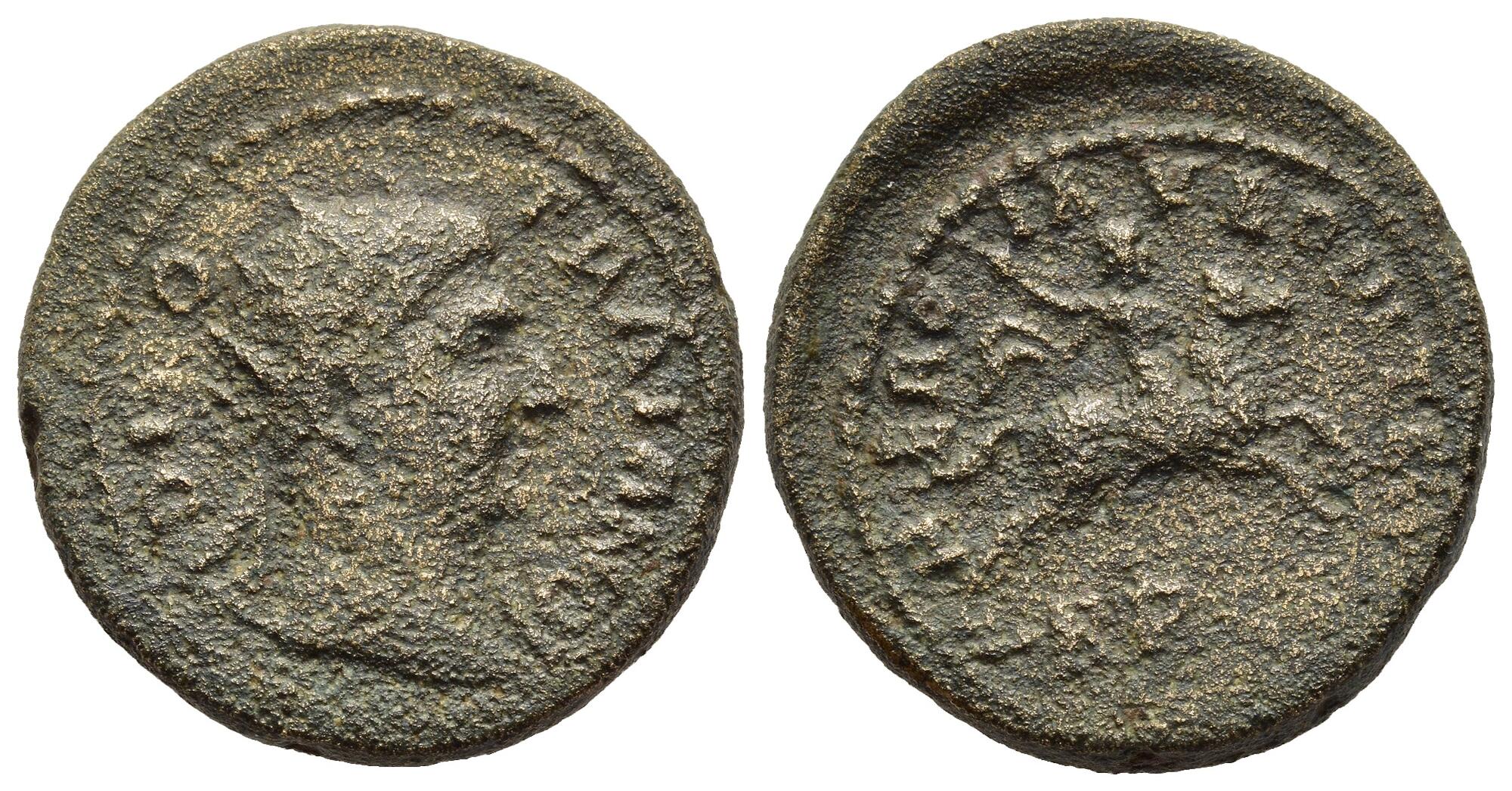Philippi (Gallienus), bronze (218-268 CE)
From SILVER
218 CE - 268 CE Bronze
Description
| ObverseInscription or printing placed on the obverse.: | Various legends : 1) DIVO AVGVSTO ; 2) DIVO TRAIANO ; 3) DIVO MAR ANTONIO (latin).Various types. Radiate bust right, slight drapery |
| ReverseInscription or printing placed on the reverse.: | Various legends : 1) HEROI AVLONITE RPCP ; 2) AVG PARENTI DIVO ; 3) PRINC IVBENTVTIS RPCP ; 4) LIBERO PATRI RECIANO PC ; 5) SPES PVBLICA RPPC (latin).Various types. The hero Aulonites on horseback right, brandishing a lance, RPCP in exergue |
Mint and issuing power
| MintIdentifies the place of manufacture or issue of a numismatic object.: | Philippi | Ancient regionAncient region.: | Macedon | Modern countryModern country: Greece | AuthorityIdentifies the issuing power. The authority can be "pretended" when the name or the portrait of X is on the coin but he/she was not the issuing power. It can also be "uncertain" when there is no mention of X on the coin but he/she was the issuing power according to the historical sources: | Gallienus (Roman emperor, 218-268 AD) |
Chronology
| FromIdentifies the initial date in a range assigned in a numismatic context. | 218 CE | toIdentifies the final date in a range assigned in a numismatic context.. | 268 CE | PeriodTime period of the numismatic object.: Roman from 30 BC |
Physical description
| MetalThe physical material (usually metal) from which an object is made.: | Bronze |
Median weightMedian of the weights of numismatic objects (in grams). in grams | 10.00 | DenominationTerm indicating the value of a numismatic object. Examples: tetradrachm, chalkous, denarius.: | StandardStandard.: |
Image

S 732 - Philippi Gallienus (218-268 CE).jpg [1]
References
| Die study referencePublication of the study: | Amandry 19981Amandry 1998, p. 23-31. | ||
| Coin series referenceReference to coin series study: | |||
Obverse dies distribution
| FrequencyFrequency of specimen in distribution. ᵖ | Number of obversesNumber of obverse dies. ᵖ (o) | % (o) | Number of coinsNumber of coins. (n) | % (n) | Die nameName(s) of the die(s). |
| 5 | 1 | 33.33 | 5 | 23.81 | 1 |
| 7 | 1 | 33.33 | 7 | 33.33 | 2 |
| 9 | 1 | 33.33 | 9 | 42.86 | 3 |
| Total | 3 of 3 | 99.99 | 21 of 21 | 100 |
Reverse dies distribution
no distribution is available
Quantification
| Number of obversesNumber of obverse dies. ᵖ (o) | 3 | Number of singletons (o1)The number of singleton coins. ᵖ | |
| Number of reverse diesNumber of reverse dies. (r) | 6 | Number of coinsNumber of coins. (n) | 21 |
| Coins per obverse dieNumber of coins per obverse die. (n/o) | 7 | Coins per reverse dieNumber of coins per reverse die. (n/r) | 3.5 |
| Reverse per obverse ratioRatio of obverse dies divided by reverse dies. (r/o) | 2 | Percentage of singletons (o1)number of coins (n) divided by the number of singletons (o1) ᵖ | % |
| Original number of dies (O) (Carter 1983 formula)The estimation of the number of coins according to Carter 1983 ᵖ | 3.16 | Coins struck if 20,000 as average productivity per dieCoins made if the average productivity for obverses (according to Carter) is 20,000. ᵖ | 63,200 |
| Original number of dies (O) (Esty 2011 formula)The estimation of the number of coins according to the singleton formula in Esty 2011 ᵖ (O) | 3.5 | Survival rate if 20,000 as average productivity per dieSurvival rate if average productivity is 20,000. ᵖ | 0.00033 |
| Coverage (o = % of O) (Esty 1984 formula)Esty 1984 - coverage (% of O) ᵖ (o = % of O) | % | Die productivity if survival rate 1/2,000Average productivity if survival rate is 1/2,000. ᵖ | 13,291.14 |
| Weight of silver (in kg) if 20,000 coins per die (O = Carter formula)Carter 1983 * Median weight * 20000 (*10 if gold or electrum) ᵖ | n.a. | Die productivity if survival rate 1/5,000Average productivity if survival rate is 1/5,000. ᵖ | 33,227.85 |
Remarks
Most likely two workstations
References
- ^ Amandry, Michel (1998), "Le monnayage de la Res Publica Coloniae Philippensium", in Ulrike Peter (ed.), Stephanos nomismatikos : Edith Schönert-Geiss zum 65. Geburtstag, Berlin, p. 23-31.